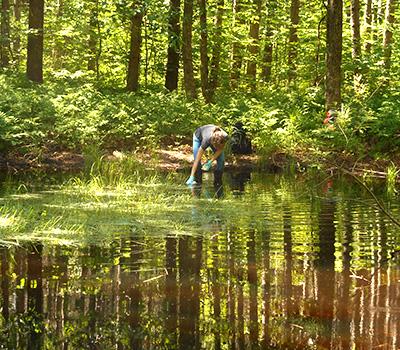Landscape Influence on Vernal Pool Mercury Levels, Cycling, and Bioaccumulation

Vernal pools, or temporary seasonal wetlands, are unique ecosystems in northeastern forests that provide critical habitat for a diversity of invertebrates and amphibians. Several species of frogs and salamanders rely on these pools for breeding and larval development. Vernal pools are also potential “hotspots” for mercury transformation to toxic methylmercury. Methylmercury is a potent neurotoxin that bioaccumulates through food webs and can reach critical levels in sensitive wildlife populations.
NSRC researchers measured methylmercury levels and other chemical parameters in 21 vernal pools across a mix of hardwood and softwood forests in Vermont and assessed mercury levels in invertebrates and amphibians. Researchers observed elevated levels of methylmercury in the vernal pools, relative to other natural bodies of water, and concentrations increased throughout the growing season. Pools supported conversion of mercury to methylmercury, with proportions of methyl to total mercury reaching up to 40%.
Spotted salamander tadpoles and adults had higher levels of mercury than did wood frogs. This is likely due to the more predatory feeding habits of salamander larvae and the significantly longer life span of salamander adults. Predatory beetles, as well as fairy shrimp, which spend their entire life cycle in vernal pools, accumulated more mercury than did detritus-feeding caddisflies and mosquito larvae. Findings emphasize the sensitive nature of forest vernal pools and the species they support. Inputs of mercury, which can be augmented by land disturbances and climate change-related increases in runoff, can be efficiently methylated and taken up into pool fauna, where methylmercury can reach high levels in sensitive species and be transferred to terrestrial food webs.
